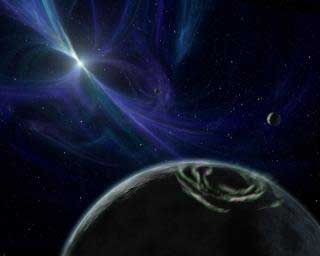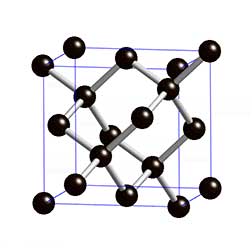Diamond planets are a girl’s best friend
Usually people look deep into the Earth to find diamonds, not out into space. But an international team of astrophysicists recently discovered a planet about 4,000 light years away from the Earth that seems to be primarily made of a crystalline carbon—which would make it the densest planet and the biggest diamond ever discovered!
It wasn’t the sparkle that caught the attention of astronomers, but a radio signal. The planet was found during a systematic search for pulsars, which are neutron stars, very dense, rapidly rotating stars that emit beams of radiation [for more on neutron stars, see You are My Shining Star]. If a pulsar is oriented so that the beam is directed toward the Earth at some point during the pulsar’s rotation, and the beam is strong enough, instruments on Earth will be able to pick up this characteristic signal.
This particular search for pulsars used data from a radio telescope at the CSIRO (Commonwealth Scientific and Industrial Research Organization) Parkes Observatory in Australia. While analyzing the data, scientists saw the characteristic pattern of a pulsar coming from a specific area of the sky, and so they studied the same spot with two other radio telescopes. The signal was there—but something was off.
The signal from this particular star (eventually named PSR J1719-1438) was altered in a way that indicated that it was being orbited by a planet. This wasn’t the first time that scientists found a planet orbiting a pulsar. In fact, the first planets to be discovered outside of the solar system were orbiting a pulsar, and were detected by a similar method in 1992.
 An example of a pulsar signal. The x-axis indicates where the pulsar is in its rotational cycle (0-1 represents one rotation of the pulsar, and 1-2 another). The y-axis describes the intensity of the signal. Courtesy of Jim Lochner & NASA |
 This artist's concept depicts a pulsar planet system discovered by Aleksander Wolszczan in 1992. Wolszczan used the Arecibo radio telescope in Puerto Rico to find three planets - the first of any kind ever found outside our solar system - circling a pulsar named PSR B1257+12. All three pulsar planets are shown in this picture; the farthest two from the pulsar (closest in this view) are about the size of Earth. Credit: NASA/JPL-Caltech |
The signal from PSR J1719-1438 and how it changes with time contains a lot of information about the pulsar and the planet. From this information, astrophysicists determined that the pulsar rotates about 10,000 times in one minute. The planet orbits the pulsar closely, and completes an orbit once every two hours and ten minutes. The planet is small—about five times the size of the Earth, but is extremely dense.

One block in a diamond lattice. The black spheres represent carbon atoms and the gray bars represent the bonds between the atoms. In diamond, this pattern repeats in all directions. Public domain.
This density is the reason that astrophysicists believe the planet is diamond-like. The size constraints rule out the presence of lighter elements like helium and hydrogen, and indicate that the planet is composed primarily of carbon, with some oxygen. Under such high pressure it is likely that the carbon crystallized, like in a diamond.
A diamond is composed of carbon atoms arranged in a specific, rigid pattern, called a lattice. The pattern repeats in all directions, and the bonds between the atoms are very stiff. This arrangement is what makes diamond such a hard material and so resistant to scratches.
So how do you end up with a diamond planet orbiting a pulsing star? The most likely scenario is that planet is actually the core of a once massive star, kind of like our sun. When it and the pulsar were young stars, they formed a binary system—they orbited around the same center of mass. When the most massive star ran out of nuclear fuel it exploded as a supernova, and some of the remnants of the supernova contracted to form the pulsar. When the second, less massive star ran out of nuclear fuel, it expanded and the gravity of the pulsar pulled in almost all of the second star’s mass. Eventually, the two bodies reached equilibrium—as a massive pulsar spinning rapidly and a small, dense planet orbiting a close, but safe distance from the pulsar.
As for how this planet would look on a giant engagement ring, astronomers are not quite sure. But whatever the surface of the planet looks like, few women are likely to turn town a 1031 carat diamond!
For more information on the diamond planet and to learn more about pulsars, check out the following resources:
Watch this video to hear the team leader, MatthewBailes of Swinburne University of Technology in Melbourne, describe the discovery.
CSIRO: The Dish finds a diamond planet
Read the media release from the CSIRO Parkes Observatory.
NASA’s Imagine the Universe: Pulsars
Explore pulsars and how they form.
Australia Telescope Outreach and Education: An Introduction to Pulsars
Find out more about how pulsars were discovered and read about current areas of research.
NASA’s Imagine the Universe: White Dwarf Stars
Read about which stars become white dwarfs, and what the process is like.
About.com: Chemistry of Diamond
Learn about the structure, properties, and types of diamonds.















